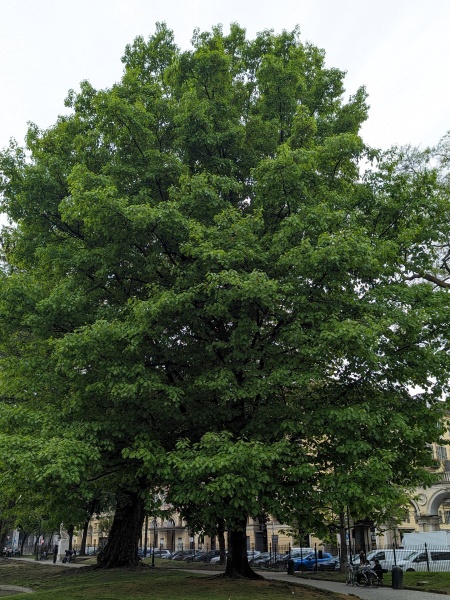 Known to be toxic - Toxic to mammals if ingested.
Known to be toxic - Toxic to mammals if ingested.

Source: Ivan Ruggiero
Quercus rubra
Northern Red Oak
Chêne rouge
Synonyms
red oak
chêne boréal
Seeds in stock
Available at table Vines, Shrubs, Trees
Available at table Vines, Shrubs, Trees
We currently accept seeds for this plant
Bloom Colour: Green
Bloom Period: May - May
Max Height: 75.0 feet
Max Width: 30.0 feet
Light Condition:
 More than 6 hours of direct sun a day
More than 6 hours of direct sun a day
 More than 2 or 3 hours but less than 6 hours of direct sun a day
Soil conditions:
More than 2 or 3 hours but less than 6 hours of direct sun a day
Soil conditions:
 Tolerates medium soil condition
Tolerates medium soil condition
 More than 6 hours of direct sun a day
More than 6 hours of direct sun a day
 More than 2 or 3 hours but less than 6 hours of direct sun a day
More than 2 or 3 hours but less than 6 hours of direct sun a day
 Tolerates medium soil condition
Tolerates medium soil condition
Lifespan:
Perennial
plants that will that come back year after year
Gardener Experience:
 Does not spread uncontrollably
Does not spread uncontrollably
 Easy to germinate
Easy to germinate
 Self-seeding
Self-seeding
 Does not spread uncontrollably
Does not spread uncontrollably
 Easy to germinate
Easy to germinate
 Self-seeding
Self-seeding
Landscape Uses:
No landscape information available.
Ecological Benefits:
 Supports pollinators
Supports pollinators
 Keystone species
Keystone species
 Supports pollinators
Supports pollinators
 Keystone species
Keystone species
Tolerates:
 Tolerates foot traffic around the plant
Tolerates foot traffic around the plant
 Tolerates limestone conditions
Tolerates limestone conditions
 Tolerates acidic soil conditions
Tolerates acidic soil conditions
 Tolerates juglone conditions
Tolerates juglone conditions
 Tolerates foot traffic around the plant
Tolerates foot traffic around the plant
 Tolerates limestone conditions
Tolerates limestone conditions
 Tolerates acidic soil conditions
Tolerates acidic soil conditions
 Tolerates juglone conditions
Tolerates juglone conditions
Special Features and Considerations:
Plant Location
Native to Ottawa region: Yes
Distribution according to VASCAN

Ephemeral
Native
Introduced
Excluded
Extirpated
Doubtful
Absent
Thrives in Ecozones
- Atlantic Maritime
- Mixed Wood Plains
Ecological Benefits
Butterflies Supported by Quercus rubra
- Antheraea polyphemus (Polyphemus)
- Apatelodes torrefacta (Spotted Apatelodes)
- Eacles imperialis (Imperial)
- Erynnis horatius (Horace's Duskywing)
- Erynnis juvenalis (Juvenal's Duskywing)
- Eupithecia miserulata (American Common Pug)
- Haploa clymene (Clymene)
- Limenitis arthemis ssp. astyanax (Red Spotted Purple)
- Paonias excaecata (Blinded Sphinx)
- Polygonia faunus (Green Comma)
- Prochoerodes lineola (Large Maple Spanworm)
- Satyrium calanus (Banded Hairstreak)
- Satyrium caryaevorus (Hickory Hairstreak)
- Satyrium liparops (Striped hairstreak)
Specialized Bees Supported by Quercus rubra
No bee data available for this plant.
Plants that grow in similar conditions, that bloom at the same time.
Complementary Plants
- No complementary plants found.
Substitute For Non-Native Plants
- Rhamnus cathartica (Common Buckthorn)
- Rhamnus frangula (Glossy Buckthorn)
- Magnoliaceae (Magnolia)
- Acer japonicum (Japanese Maple)
- Acer platanoides (Norway Maple)
- Juglans nigra (Black Walnut Cultivar)
Sowing Information
Download Seed Envelope Labels (PDF)
- Sowing depth: Sow 1 inch deep
- Sow by January
- Stratification duration: 90 days
- Self-seeding
- Notes: Soak for 24h.
Harvesting and Seed Sharing
- Harvest start month: September
- Harvesting indicator:
- Pods are released from plant
- Harvesting:
- Nut has been released from tree
- Seed viability test:
- Put seed in container filled with water
- If the seed goes at the bottom of the container, you can donate
- If seed floats, do not donate
- Packaging measure: Six (6) seeds (eyeball)
- Seed storage:
- Air dry in paper bag or open container, for a few days until crisp
- Shake seeds to move them once in a while to prevent molding
- Cultivar: Yes, do not donate unless you know source, and there are no known cultivars in your garden or at proximity
- No harvesting video available at this time.
Toxicity Notes
Toxic to mammals if ingested.


 Canadensis
Canadensis
